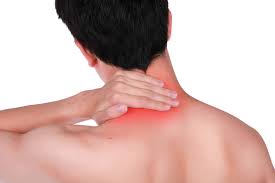
Our neck is made up of vertebrae that extend from the skull to the upper torso. Cervical discs absorb shock between the bones. The bones, ligaments, and muscles of the neck hold our head and perform other functions including movement of the head and neck. Any injury, inflammation or abnormalities can lead to neck pain, coupled with stiffness.
Neck pain is a common malady. Many people experience neck pain occasionally. Neck muscles can be tensed up from poor posture – be it leaning over your desktop or hunching over to take something. Neck pain can arise due to overuse of the neck as well. Osteoarthritis is also a common trigger for neck pain. Sometimes neck pain is caused by injury from a fall, contact sports or whiplash from a motor vehicle accident. Seldom, neck pain can be a symptom of a more sinister underlying problem. It is time to get medical attention if your neck pain is accompanied by numbness or loss strength in your upper extremities or if you have radiating pain into your shoulder or down your arm. If you have neck pain that lasts more than a week and is accompanied by other symptoms, seek medical care immediately.
Causes of neck pain:
Neck pain can be set off due to a variety of causes.
Muscle tension and strain:
This is largely due to behavioral issues such as:
- poor posture
- working at a desk for a prolonged time without changing position
- sleeping with your neck in a bad position
- jerking your neck during exercise
Injury:
Neck is prone to injury, especially in falls, motor vehicle accidents and contact sports where the muscles and ligaments that support the neck are forced to move out of their normal range. If cervical vertebrae (neck bones) are fractured, there are chances of spinal cord also being damaged. As for motor vehicle accidents, sudden jerks of the neck lead to whiplash injury.
Meningitis:
Meningitis is the inflammation of the thin tissue that surrounds the brain and spinal cord. In people with meningitis, neck pain is coupled with fever and headache.
Other causes of neck pain:
- Rheumatoid arthritis
- Osteoporosis
- Fibromyalgia
- Herniated cervical disc
- Spinal stenosis
Symptoms associated with neck pain:
Neck pain is a symptom commonly associated with dull aching. Sometimes, movement of the neck or turning the head may worsen the already aching neck. Other common symptoms associated with neck pain include tingling, tenderness, sharp shooting pain, range-of-motion difficulties, fullness, difficulty swallowing, pulsations, swishing sounds in the head, dizziness or lightheadedness, and lymph node swelling.
With neck pain you can also notice some offshoot symptoms such as headache, facial pain, shoulder pain, and arm numbness or upper extremity paresthesias. These associated symptoms are generally as a result of nerves getting pinched in the neck. At times neck pain is also accompanied by symptoms such as upper back and/or lower back pain, as is common in inflammation of the spine from ankylosing spondylitis.
Treatment for neck pain:
Physiotherapy is one of the most effective treatments for both chronic and mild neck pain. Most physiotherapy sessions for neck pain involve targeted treatments to ameliorate pain and stiffness enough to start an exercise regimen of strengthening the neck muscles and improving the flexibility of neck. However, physiotherapy is a tailor-made treatment program, which means it varies from person to person, depending on the nature and degree of the pain. The duration, specific methods and exercises are determined after careful analysis of the patient’s conditions.
The following goals are aimed to achieve by using physiotherapy for neck pain.
- Reduce pain and stiffness
- Improve head and neck range of motion
- Develop dynamic strengthening of the neck and its supporting musculature
- Develop strategies to prevent pain from recurring
Methods of physiotherapy treatment:
Passive physiotherapy: As the name indicates, this mode of physiotherapy is discharged “passively”, which means without effort from the patient. Numerous treatment methods are available, such as applying ice packs, heat therapy, massage therapy, electrotherapy and others. The primary objective of passive physiotherapy is to reduce pain and swelling.
Active physiotherapy: This involves “active” participation of the patient by moving his or her own body through exercises and stretches. By bolstering the strength and flexibility in the neck, these muscles may become less painful and help in maintaining good posture, which reduces cervical spine being stressed.
Physiotherapy generally begins with passive mode of treatments, but more and more of active treatments are incorporated as the patient makes improvement in the condition.
Efficacy of physiotherapy:
Many medical studies suggest strong evidence supporting the benefits of physiotherapy in the treatment of neck pain, both by strengthening neck muscles and improving the range of motion. Some studies found even more benefits from physiotherapy when combined with proper exercise programs.
The principal advantage of physiotherapy is improving the strength of neck muscles may help them to better support the cervical spine and they become more resistant to pain. As for whiplash injuries, it damages the soft tissues and joints of the neck and the resultant pain and stiffness can last for weeks or much longer. A targeted physiotherapy program can reduce the pain and help return the neck to normal functioning.










